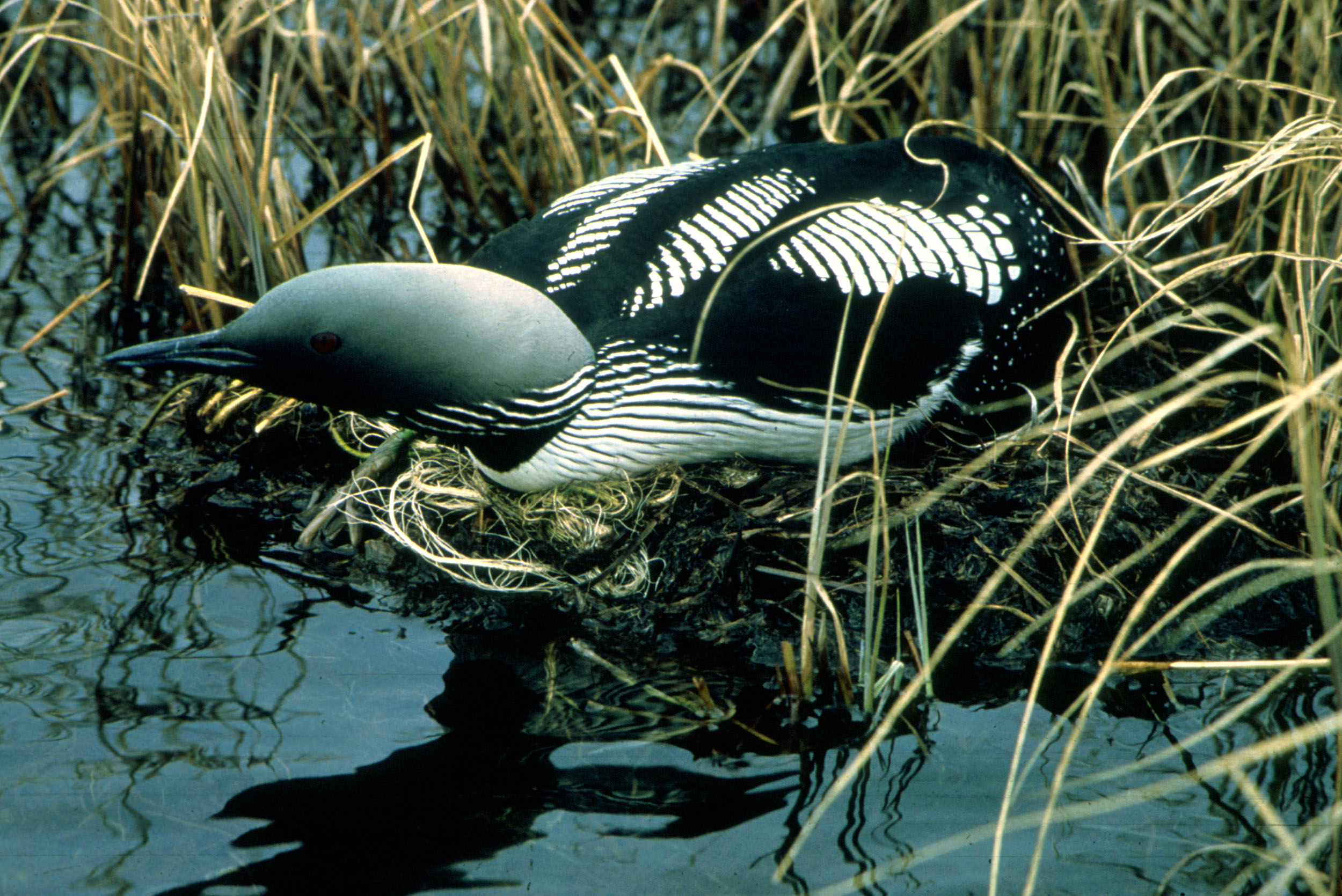- Black-throated Diver
Taxobox
name = Black-throated Diver
status = LC
status_system = iucn3.1
status_ref = [IUCN2006|assessors=BirdLife International |year=2004|id=49672|title=Gavia arctica|downloaded=2006-05-09 ]

image_width = 240px
regnum =Animal ia
phylum =Chordata
classis =Aves
ordo =Gaviiformes
familia =Gaviidae
genus = "Gavia "
species = "G. arctica"
binomial = "Gavia arctica"
binomial_authority = (Linnaeus, 1758)
subdivision_ranks =Subspecies
subdivision =
* "G. a. arctica"
* "G. a. "viridigularis"Black-throated Diver ("Gavia arctica"), known in
North America as Arctic Loon, is a medium-sized member of theloon or diver family.Description
Breeding adults are 63 cm to 75 cm in length with a 100 cm to 122 cm wingspan, shaped like a smaller, sleeker version of the
Great Northern Diver . They have a grey head, black throat, white underparts and chequered black-and-white mantle. Non-breeding plumage is drabber with the chin and foreneck white. Its bill is grey or whitish and dagger-shaped. In all plumages a white flank patch distinguishes this species from all other divers including the otherwise almost identicalPacific Diver .Distribution
It breeds in
Eurasia and occasionally in westernAlaska . It winters atsea on largelakes over a much wider range.Behaviour
This
species , like all divers, is a specialistfish -eater, catching itsprey underwater. It flies with neck outstretched.The call is a yodelling high-pitched wail.
Miscellaneous
The Black-throated Diver is one of the species to which the "Agreement on the Conservation of African-Eurasian Migratory Waterbirds" (
AEWA ) applies.Instructions for constructing and deploying artificial floating islands to provide Black-throated Divers with nesting opportunities are given in Hancock (2000).
On
September 6 ,2007 ,RSPB Scotland and theScottish Natural Heritage (SNH) stated that it was surprised by an increase in the last 12 years in the breeding figures in theUK for theRed-throated Diver and the rarer Black-throated Diver of 16% and 34% respectively due to theanchoring of 58 man-maderafts inlochs . Both species decreased elsewhere inEurope .Dr Mark Eaton, RSPB
scientist traced the drop in overall numbers to warming of theNorth Sea which reduced stocks of thefish on which they feed. [ [http://news.bbc.co.uk/2/hi/uk_news/scotland/highlands_and_islands/6980265.stm BBC NEWS, Rise in divers mystifies experts] ]References
* Hancock, Mark (2000): Artificial floating islands for nesting Black-throated Divers "Gavia arctica" in Scotland: construction, use and effect on breeding success. "Bird Study" 47: 165-175. [http://www.ingentaconnect.com/content/bto/bird/2000/00000047/00000002/472165 HTML abstract]
* Harrison, Peter (1988): "Seabirds" (2nd ed.). Christopher Helm, London ISBN 0-7470-1410-8
*
National Geographic Society (2002): "Field Guide to the Birds of North America". National Geographic, Washington DC. ISBN 0-7922-6877-6External links
* [http://ibc.hbw.com/ibc/phtml/especie.phtml?idEspecie=76 IBC] Videos on the Internet Bird Collection
* [http://www.flickr.com/search/groups/?w=42637302@N00&q=black-throated+diver&m=pool Flicker Field Guide Birds of the World] Photographs
* [http://blx1.bto.org/birdfacts/results/bob30.htm - BTO BirdFacts- Black-throated Diver]Further reading
The following articles deal with separation of Pacific Diver from Black-throated Diver:
* Birch, A. and Lee, C-T, 1997, Field identification of Arctic and Pacific Loons, "Birding" 29: 106-115.
* Birch, A and Lee, C-T, 1995, Identification of the Pacific Diver - a potential vagrant to Europe, "Birding World " 8: 458-466.
Wikimedia Foundation. 2010.
